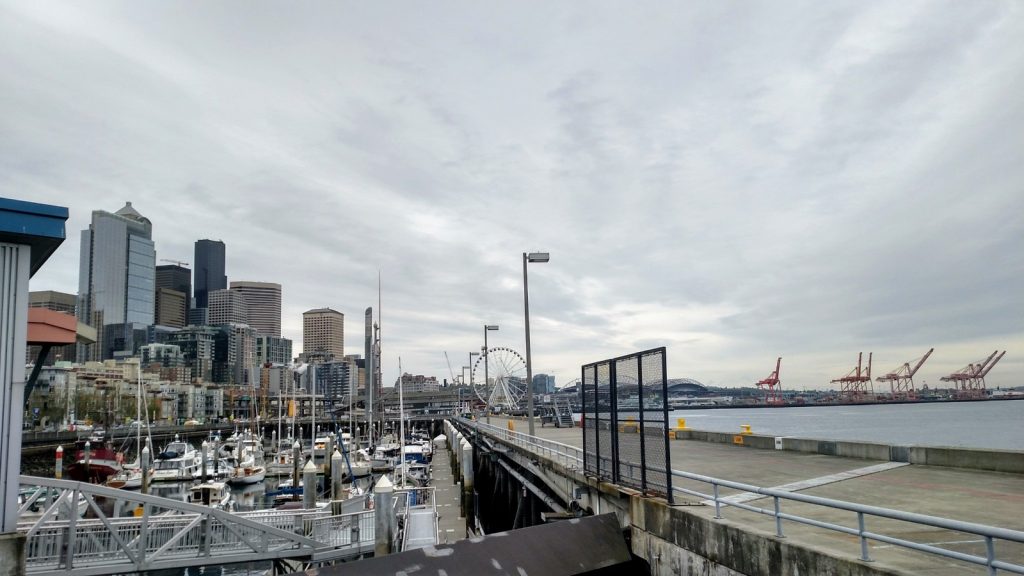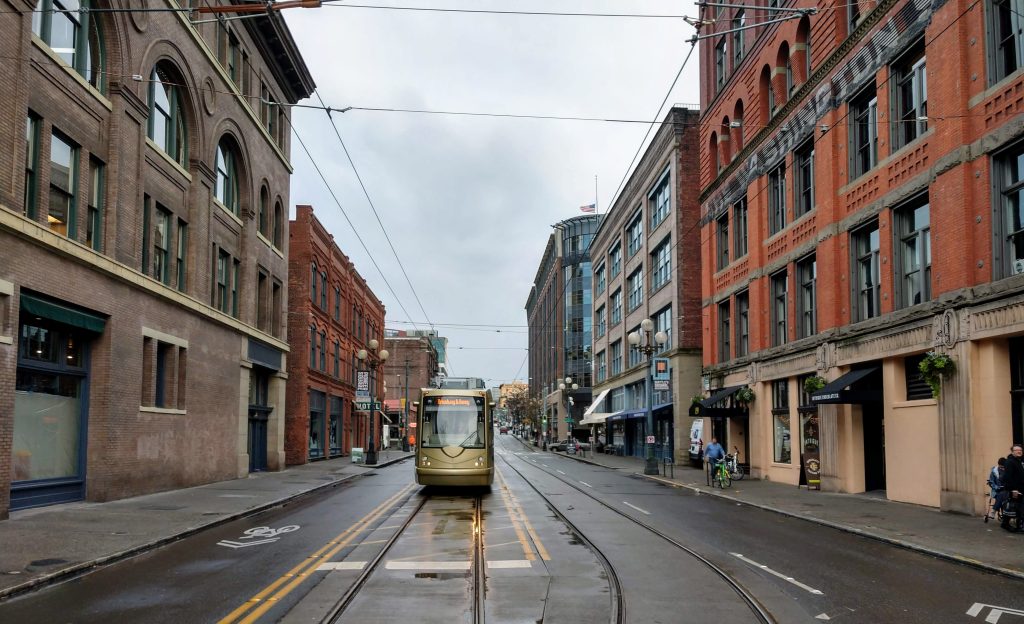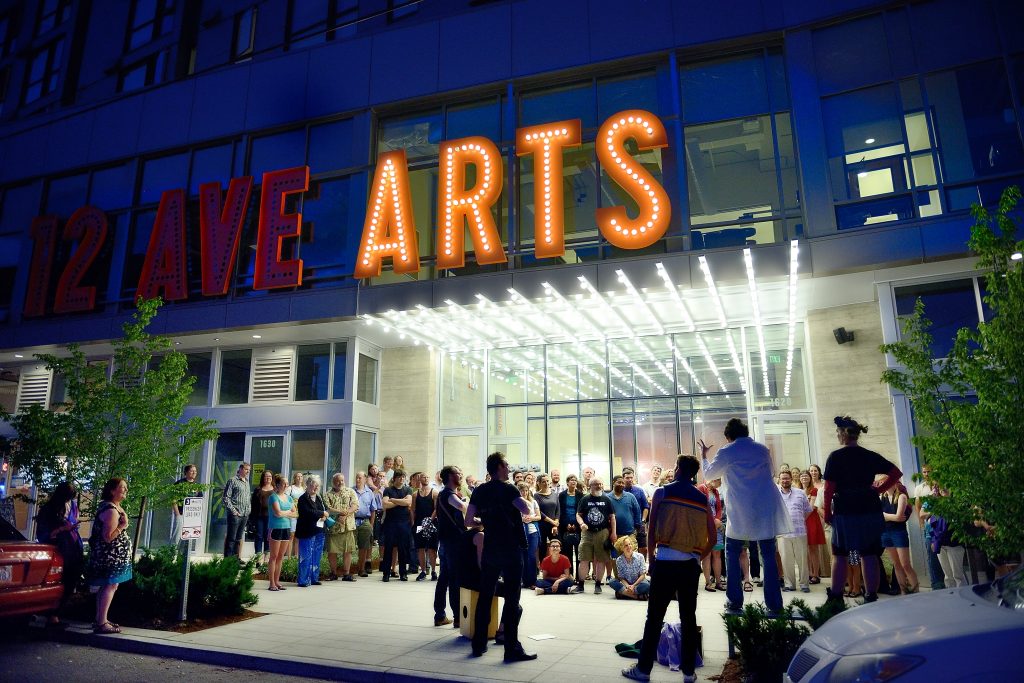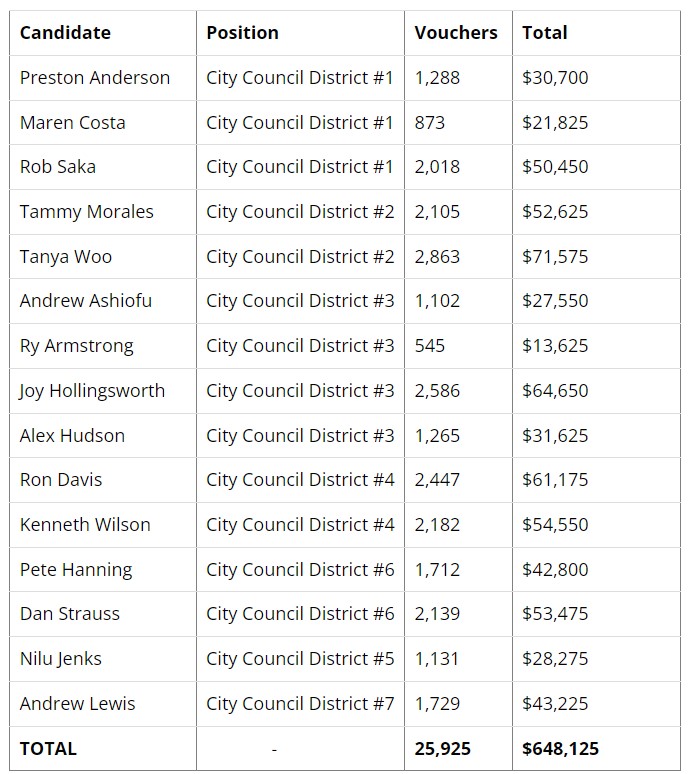As a queer non-binary Broadway actor running as a radical Democratic socialist urbanist, Ry Armstong is mounting one of the more unique bids for Seattle City Council in District 3. One of their audacious proposals is to pedestrianize Pike Street and run a streetcar up it, creating a loop with the existing streetcar system, as The Urbanist learned in an interview with the candidate.
“I want to close Pike to cars all the way up the Hill from the [Pike Place] Market all the way up,” Armstrong said “I think Seattle needs a restaurant row. We need a tourist space where people can feel comfortable enough and have a promenade up that entire interchange. And a portion of that is taking the current streetcars and South Lake Union Transit cars and combine them into a one-way circular loop that can get you around the interior of the city without having to transfer from one direction to the other direction. It’s just nonsensical the kind of disparate transit systems we have.”
District 3 is the busiest council district with 10 candidates declared to replace Councilmember Kshama Sawant who is leaving to form a new national workers party. The Urbanist has published interviews with Alex Hudson, Efrain Hudnell, and Andrew Ashiofu, who all bring their own urbanist credentials. Armstrong has their own case to make with a campaign centered on shelter, safety, and sustainability.
Right to Shelter
“Within the first six months, I would want to pass the right to shelter within Seattle,” Armstrong said. “So that’s my top, most immediate priority.”
With several policy ideas informed by their time living in New York, Armstrong said their shelter plan was inspired by New York’s right to shelter system.
“New York had a lawsuit that happened from a family of a resident who died in the blizzard who was houseless at the time; they sued the city and they won in court,” Armstrong explained. “They created a legal precedent called the right to shelter. And other cities have taken on this legal right, this precedent, where there is a baseline of universal housing, someone calls 3-1-1 or 9-1-1, whatever the phone number is, they are required to be housed by the city legally within 24 to 48 hours, or the city pays fines to the court system.”
“And that’s a check and balance that we need here, because Seattle has a perfectionism problem where we’re too scared to take action because we might fail at something,” they continued. “And I think it’s time to bleed a little bit of money in the beginning because it’s gonna be expensive upfront, but we will have to innovate and figure out how to solve the problem. Instead of I’m walking around cap hill and I’m seeing people that need help and don’t have access to the different diaspora of resources: gotta go down to Pioneer Square to get your SNAP benefits. And you gotta go here to get that. And it’s like, we need a centralized place to house these people.”
Naval Ships to House Homeless
Again, here Armstrong demonstrates their penchant to think outside the box, suggesting that obsolete naval ships could be conscripted into service as waterfront shelters for unhoused Seattleites.
“I have this crazy radical idea to ask the federal government, whether through Patty Murray’s office or Maria Cantwell’s to donate the, I think, 32 large naval ships they were retiring,” Armstrong said. “And so I want to park one or two of them in the port and cement them… In New York, there’s this museum called the Intrepid, which is an aerospace museum and has an entire space shuttle on it. And as I was walking by, I was like, you know, if we can house giant planes, we can probably house people.”

“So I want to put those in the port of Seattle and make it something that we’re not afraid of showing, you know, we care for our people and anyone can go there and get all of their benefits in one place, and or have housing for the night. I mean, you could create upwards to 1,500 units of housing with one to two of these ships that are just there. They need to be refurbished a lot, let me tell you. Like we have to really make them livable conditions.”
Vacancy Tax to Fund Social Housing and the Arts
Armstrong is a supporter of social housing and the public developer established via Initiative 135, which passed in February, and canvassed for the measure. They propose a vacancy tax applying to empty residential and commercial units to fund the public development authority (PDA) now tasked with creating social housing.
“I’m just kind of tired of seeing vacant skyrises and we’re always complaining about supply, but there is more supply out there. So we need to incentivize the use of that space,” Armstrong said. “Like for example, the Starbucks right here on Olive Way just closing because they’re trying to union bust. Like they should be paying a vacancy tax on that property for not using it in our city… We do need to keep increasing through the PDA units of housing that are accessible and not these like luxury apartments that are four, five, six, $10,000 a month. That’s just ridiculous. Like who’s gonna afford that?”
There would be ways to earn exemption from the vacancy tax, Armstrong said, by renting out the space, including by repurposing rental units for subsidized housing for the unhoused or arts pop-up spaces.
“The vacancy tax for commercial spaces would go towards creating tourism and an arts economy or creative economy here in Seattle.” Armstrong said. “The eclectic artistic nature of Seattle is why people want to come here and see it. So, if we can have pop-ups of art experiences all over the city, that would be my dream come true. And that could also be an exemption if they give the artist the space for a property owner or operator to not have to pay the vacancy tax on those commercial spaces if they give the space for a month to an artist then perhaps then they get three months without paying that tax”
Comp Plan and Housing as Climate Infrastructure
Armstrong did not give a specific preference when it came to selecting an alternative for the Comprehensive Plan Update, but they did argue the current growth strategy isn’t working well and much more housing is needed. (A few candidates have come out in favor of the most housing-dense Alternative 5 or an Alternative 6 that would go beyond it, or generally espoused values along those lines.)
“I think a business as usual plan is not only detrimental to my generation, but to the future well-being of Seattle as a climate change haven,” Armstrong said. “I think investment in transit and housing infrastructure is a war against the climate at this point. And we are not prepared for what the next century holds.”
Mentioning the controversy over the loss and threat of loss to cultural spaces in the Central District and the Chinatown-International District, Armstrong stressed the need for cultural preservation and listening to communities.
“So it’s a hard conversation,” they said. “I think we need to lean on the side of expanding the city in a way where we are sensitive to those community needs. So I find myself balancing between those two things, but I would identify myself as a pretty radical urbanist when it comes to transportation and Green New Deal investment.”
To pay for that investment, Armstrong pointed to a carbon tax — which is currently preempted by the Climate Commitment Act that established Washington State’s cap-and-trade system but potentially could be overcome through negotiating for an amendment to that law or some sort of clever workaround.
“Yeah, it’s kind of crazy, but I want to do a carbon tax,” Armstrong said. “I think the cap-and-trade system that is made on the state is not enough for businesses just to buy credits to push forward this delay tactic of really pushing our city towards being not carbon neutral, but carbon free. Carbon neutral is a very greenwash term that is used everywhere. So my thing, I think there’s a lot of federal dollars, especially that we saw in the Vision Zero plan that was identified.”
Free Fare Fridays and Getting Around Without a Car
As a car-free Seattleite, Armstrong also pointed to the need for better real-time arrival information across transit modes, better frequencies, and the need for fostering a culture around trusting transit and that trust being well-placed.
“I also think free Fridays would be something that could encourage people to use transit,” Armstrong said. “So whether that’s for all Friday or a certain time period in the evenings where there’s no need to pay, if you’re going to the games down in the stadiums, or if you want to go out on Cap Hill on a Friday night. I think that’s a good way to incentivize people to, one, use transit, but also get used to it. I think there’s a trust there, right? You want to know that you’re going to get to your place on time and, and know that it’s gonna be running effectively and efficiently. So we need to invest in that cultural expectation.”

They also gave a shoutout to sidewalk maintenance.
“Personally, I have my little Razor scooter from when I was in high school. I don’t own a car. I walk everywhere. I take transit everywhere,” Armstrong said. “So I take my bike and my little scooter on sidewalks and these sidewalks in Capitol Hill. Oh my God. They’re like, it’s crazy. I think I’m going to die every time I try to go over to the Central District and just up to Trader Joe’s and back down. So yeah, there’s a lot of improvements we could and need to make. And it’s about finding the progressive taxation and the willpower to actually want to do that.”
Armstrong noted they thought the City’s Vision Zero campaign and its new action plan isn’t going far enough.
“I thought the [Vision Zero] report was disappointing. If this has been seven years of growth in data, I don’t know how we got here. I’m kind of tired of reporting, honestly. That’s just me giving my personal opinion. No one asked for that. But I think we need to build out the infrastructure, pedestrian first. We need people that actually walk the city and bike the city, people that aren’t drivers to be creating these transportation infrastructures.”
Queer Non-Binary Representation
While noting gender and sexual orientation doesn’t define them, Armstrong said it would be beneficial to break the glass ceiling of non-binary representation on city councils of major U.S. cities.
“There hasn’t been a queer person to represent Capitol Hill because Kshama has been in the seat for so long. So, if elected, that would happen with me. Also, there’s not been a non-binary person on any major American city council, which is crazy to me. So, if elected, that would also happen.”
Along with strengthening Capitol Hill’s identity as a gayborhood, Armstrong also wants to reinvigorate the arts scene.
“I feel like people don’t know that Capitol Hill is the arts district of Seattle because the major arts organizations are kind of in Seattle Center and then along like the Fifth Avenue Theater, Benaroya Hall, this like little corridor. So I kind of want to bring the arts back to Cap Hill. It was very different 10 years ago when I was a high schooler and exploring and living and going to Dick’s [Burgers] and not seeing all this modular housing on Broadway. It’s okay. This is my conflict as someone who believes in urbanist ideals, but wants to protect the culture.”
Arts and Queer Culture Preservation
That Capitol Hill arts scene goes back more than a century to when the neighborhood even was named for it.
“Not many people know that Capitol Hill was not always called Capitol Hill,” Armstrong said. “At one point it was called Broadway Hill because of the amount of theaters in the 1920s, the vaudeville theaters that were here, and also the art-centric nature of this particular neighborhood when Seattle was founded. And then some guys were like ‘we don’t want the Capitol in Olympia; we want it in Seattle. We’re renaming it Capitol Hill.’ And then here we are.”

The process of moving back to Seattle after several years in New York to pursue a career on Broadway underscored for Armstrong the need for protecting trans folks, the queer community, and the cultural spaces that were under threat and disappearing — with the stress of the pandemic amplifying all of those pressures.
“This is like the down and dirty rough version of my life: When the pandemic happened, I moved home and was quarantined back in my old family home, negotiating how to navigate that, which was wild. And I found myself falling back in love and missing the home I had left to try to do this Broadway thing,” they said.
“So I was home for nine months and then got a call and went back to New York to do a TV show for nine more months, which wrapped up about July 2021,” Armstrong continued. “And then my grandparents were at end of life. I lost one to Covid, and then I just wanted to be back here more often, found myself flying back and staying longer, longer times…
Some things were different about Seattle. They noticed fewer queer folks in Capitol Hill and an uptick in transphobic or homophobic incidents that made people feel unsafe.
“So I just found myself back home and wanted to be with family and then reconnecting,” Armstrong said. “I started building community here and that became having conversations about policies and things that we like or don’t like in the city, hearing about trans people not feeling safe, going out to places that should be staples of the queer community.”
Democratic Socialist roots
Ultimately, Armstrong makes their pitch to District 3 voters as a democratic socialist and an artist.
“I think I’m the only democratic socialist who’s also running,” Armstrong said. “And I know that that phrase can kind of scare people sometimes, but we live in a society where Bernie Sanders meant a lot to a lot of people. And the reason I got into politics was because of him — caucusing. I caucused for his campaign in 2016 with my dad in my Kenmore Junior High gymnasium, and then went off to get my master’s in international relations because I wanted to go into policy or governance. Like that has had a huge effect on my life in understanding that storytelling as an artist is a very passive way to change people’s minds, and this is a very much more active way.”
They hope to keep a socialist in the seat, even as they critique Sawant’s combative style and seek to pursue a more collaborative one.
“I don’t want to see District 3 become a place that’s run by a moderate or more business as usual, conservative Democrat. And I’m seeing a lot of those people kind of put their face forward. I think Kshama stands for a lot of great ideas and I think her approach to those ideas was wrong. And I think people are tired of that lack of collaboration. And so that’s why I wanna kind of bring some of that love and joy back into the idea of building a city for people and for labor and workers…”
Democracy Vouchers
Armstrong has qualified for Democracy Vouchers by meeting the signature and donor threshold. Central District entrepreneur Joy Hollingsworth, Hudson, and Ashiofu have also qualified for Democracy Voucher support in District 3, with Hollingworth leading the pack in vouchers disbursed.

Doug Trumm is publisher of The Urbanist. An Urbanist writer since 2015, he dreams of pedestrian streets, bus lanes, and a mass-timber building spree to end our housing crisis. He graduated from the Evans School of Public Policy and Governance at the University of Washington in 2019. He lives in Seattle's Fremont neighborhood and loves to explore the city by foot and by bike.


